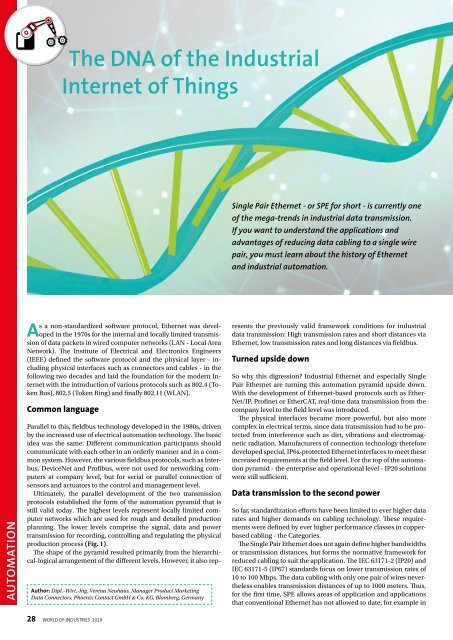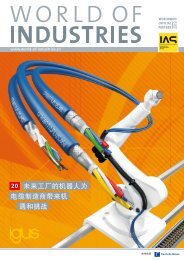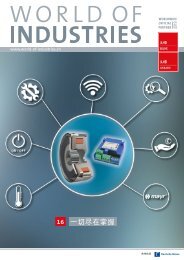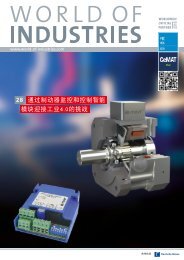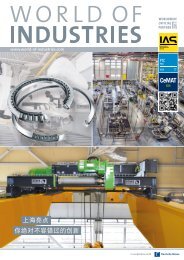WORLD OF INDUSTRIES 04/2019 (EN)
WORLD OF INDUSTRIES 04/2019 (EN)
WORLD OF INDUSTRIES 04/2019 (EN)
You also want an ePaper? Increase the reach of your titles
YUMPU automatically turns print PDFs into web optimized ePapers that Google loves.
The DNA of the Industrial<br />
Internet of Things<br />
Single Pair Ethernet - or SPE for short - is currently one<br />
of the mega-trends in industrial data transmission.<br />
If you want to understand the applications and<br />
advantages of reducing data cabling to a single wire<br />
pair, you must learn about the history of Ethernet<br />
and industrial automation.<br />
AUTOMATION<br />
As a non-standardized software protocol, Ethernet was developed<br />
in the 1970s for the internal and locally limited transmission<br />
of data packets in wired computer networks (LAN - Local Area<br />
Network). The Institute of Electrical and Electronics Engineers<br />
(IEEE) defined the software protocol and the physical layer - including<br />
physical interfaces such as connectors and cables - in the<br />
following two decades and laid the foundation for the modern Internet<br />
with the introduction of various protocols such as 802.4 (Token<br />
Bus), 802.5 (Token Ring) and finally 802.11 (WLAN).<br />
Common language<br />
Parallel to this, fieldbus technology developed in the 1980s, driven<br />
by the increased use of electrical automation technology. The basic<br />
idea was the same: Different communication participants should<br />
communicate with each other in an orderly manner and in a common<br />
system. However, the various fieldbus protocols, such as Interbus,<br />
DeviceNet and Profibus, were not used for networking computers<br />
at company level, but for serial or parallel connection of<br />
sensors and actuators to the control and management level.<br />
Ultimately, the parallel development of the two transmission<br />
protocols established the form of the automation pyramid that is<br />
still valid today. The highest levels represent locally limited computer<br />
networks which are used for rough and detailed production<br />
planning. The lower levels comprise the signal, data and power<br />
transmission for recording, controlling and regulating the physical<br />
production process (Fig. 1).<br />
The shape of the pyramid resulted primarily from the hierarchical-logical<br />
arrangement of the different levels. However, it also rep-<br />
Author: Dipl.-Wirt.-Ing. Verena Neuhaus, Manager Product Marketing<br />
Data Connectors, Phoenix Contact GmbH & Co. KG, Blomberg, Germany<br />
resents the previously valid framework conditions for industrial<br />
data transmission: High transmission rates and short distances via<br />
Ethernet, low transmission rates and long distances via fieldbus.<br />
Turned upside down<br />
So why this digression? Industrial Ethernet and especially Single<br />
Pair Ethernet are turning this automation pyramid upside down.<br />
With the development of Ethernet-based protocols such as Ether-<br />
Net/IP, Profinet or EtherCAT, real-time data transmission from the<br />
company level to the field level was introduced.<br />
The physical interfaces became more powerful, but also more<br />
complex in electrical terms, since data transmission had to be protected<br />
from interference such as dirt, vibrations and electromagnetic<br />
radiation. Manufacturers of connection technology therefore<br />
developed special, IP6x-protected Ethernet interfaces to meet these<br />
increased requirements at the field level. For the top of the automation<br />
pyramid - the enterprise and operational level - IP20 solutions<br />
were still sufficient.<br />
Data transmission to the second power<br />
So far, standardization efforts have been limited to ever higher data<br />
rates and higher demands on cabling technology. These requirements<br />
were defined by ever higher performance classes in copperbased<br />
cabling - the Categories.<br />
The Single Pair Ethernet does not again define higher bandwidths<br />
or transmission distances, but forms the normative framework for<br />
reduced cabling to suit the application. The IEC 63171-2 (IP20) and<br />
IEC 63171-5 (IP67) standards focus on lower transmission rates of<br />
10 to 100 Mbps. The data cabling with only one pair of wires nevertheless<br />
enables transmission distances of up to 1000 meters. Thus,<br />
for the first time, SPE allows areas of application and applications<br />
that conventional Ethernet has not allowed to date, for example in<br />
28 <strong>WORLD</strong> <strong>OF</strong> <strong>INDUSTRIES</strong> <strong>2019</strong>


